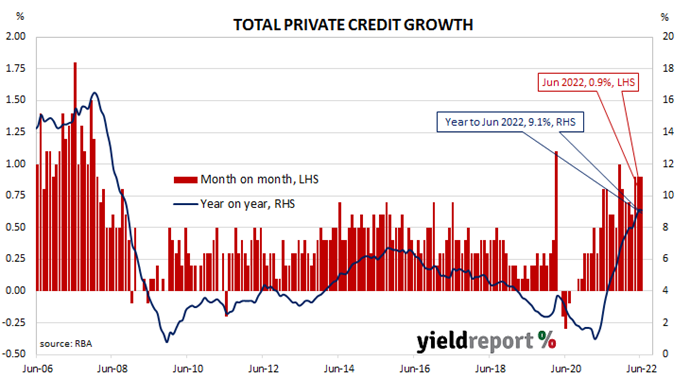Summary: Private sector credit up 0.9% in June, above expectations; annual growth rate up from 8.6% to 9.0%; “tightening of policy will dent demand for credit”; business loans account for about 55% of net growth again.
The pace of lending to the non-bank private sector by financial institutions in Australia followed a steady-but-gradual downtrend from late-2015 through to early 2020 before hitting what appears to be a nadir in March 2021. That downtrend ended later in the same year and now annual growth rates are above the peak rate seen in the previous decade.
According to the latest RBA figures, private sector credit increased by 0.9% in June. The result was greater than the 0.7% increase which had been generally expected but in line with May’s 0.9% increase after it was revised up. On an annual basis, the growth rate remained steady at 9.1% after revisions.
“Importantly, a policy u-turn is now underway. The RBA is quickly removing ultra-easy monetary policy, on the way to a contractionary stance, to fight a significant inflation challenge,” said Westpac senior economist Andrew Hanlan. “The tightening of policy will dent demand for credit, across households and businesses.”
Commonwealth Government bond yields fell heavily on the day, outpacing the substantial falls of US Treasury yields overnight. By the close of business, the 3-year ACGB yield had dropped by 20bps to 2.77%, the 10-year yield had lost 15bps to 3.08% while the 20-year yield finished 4bps lower at 3.43%.
In the cash futures market, expectations of higher rates eased. At the end of the day, contracts implied the cash rate would rise from the current rate of 1.31% to 1.75% in August and then increase to 2.08% by September. November contracts implied a 2.755% cash rate while May 2023 contracts implied 3.19%.
Business loans again accounted for about 55% of the net growth over the month, while owner-occupier loans and investor loans accounted for the balance. Total personal debt decreased a little.
The traditional driver of loan growth rates, the owner-occupier segment, grew by 0.6% over the month, down from Mya’s 0.7% increase. The sector’s 12-month growth rate slowed again, this time from 8.9% to 8.6%.
Total lending in the business sector increased by 1.5%, slightly more than the 1.4% increase recorded in May. Growth on an annual basis accelerated from 13.0% to 13.2%.
Monthly growth in the investor-lending segment slowed to a halt in early 2018. Shortly into the 2019/20 financial year, monthly growth rates slipped into the red before posting a series of flat or near-flat results until mid-2020. In June, net lending grew by 0.6%, in line with increases in March, April and May. The 12-month growth rate accelerated from 6.1% to 6.4%.
Total personal loans contracted by 0.4%, down from May’s 0.1% increase, but still slowing the annual contraction rate from 2.8% to 2.7%. This category of debt includes fixed-term loans for large personal expenditures, credit cards and other revolving credit facilities.



